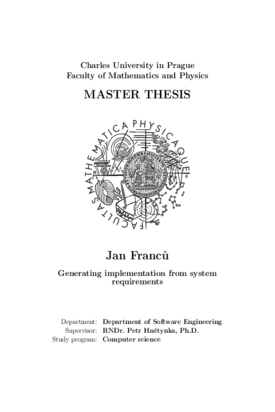Generating implementation from system requirements
Generování implementace ze systémových požadavků
diplomová práce (OBHÁJENO)

Zobrazit/
Trvalý odkaz
http://hdl.handle.net/20.500.11956/13231Identifikátory
SIS: 43676
Kolekce
- Kvalifikační práce [11325]
Autor
Vedoucí práce
Oponent práce
Adámek, Jiří
Fakulta / součást
Matematicko-fyzikální fakulta
Obor
Softwarové systémy
Katedra / ústav / klinika
Katedra softwarového inženýrství
Datum obhajoby
18. 9. 2007
Nakladatel
Univerzita Karlova, Matematicko-fyzikální fakultaJazyk
Angličtina
Známka
Výborně
Vytváření softwarového systému začíná sepsáním systémových požadavků. Obyčejně jsou tyto požadavky zapsány pomocí UML a obsahují mimo jiné use casy a domain model. Use case je sekvence úloh, které je potřeba udělat k dosáhnutí jednoho z cílů systému. Úloha je zapsána v přirozeném jazyce (angličtina). Domain model, zpravidla zachycen jako class diagram, popisuje použité objekty a jejich relace. Cílem této práce je zjistit, zda specifikace systémových požadavků jsou postačující pro generovaní implementačního modelu, který bude řídit komunikaci mezi systémovými komponentami. Model by měl být použitelný pro další vývoj a pro testovíní uživatelského rozhraní. Bude předložen prototyp programu generujícího implementační model.
Designing a software system starts with writing the system requirements. Typically, these requirements are expressed in UML and contain use cases and domain model. A use case is a sequence of tasks which have to be done to achieve one of the system's goals. These tasks are written in natural language (English). The domain model (typically captured in a class diagram) describes used objects and their relations. The goal of the thesis is to analyze, whether the system requirements are su±cient for generating an implementation model, which will manage communication between the system's components. The generated model might be used for future development and can be used for testing the users interactions. A prototype implementation of the generator is expected.
